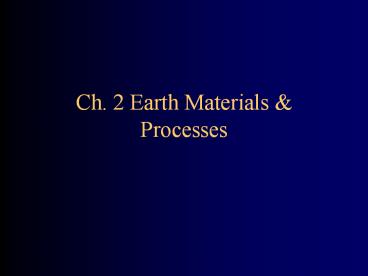Ch. 2 Earth Materials - PowerPoint PPT Presentation
Title:
Ch. 2 Earth Materials
Description:
Ch. 2 Earth Materials & Processes – PowerPoint PPT presentation
Number of Views:486
Avg rating:3.0/5.0
Title: Ch. 2 Earth Materials
1
Ch. 2 Earth Materials Processes
2
Earth Materials Processes
- Focus
- Geologic materials and processes most important
to the study of the environment - Objectives
- Acquire a basic understanding of the geologic
cycle and its subcycles (tectonic, rock,
hydrologic, biogeochemical) - Review of some of the important mineral and rock
types and their environmental significance - Appreciation/significance of geologic structures
- Appreciation of the landforms, deposits, and
environmental problems resulting from wind and
glacial processes
3
Earth Materials Processes
- Geologic cycles processes (espec. Tectonics)
- Rocks Rock Materials
- General properties
- Types/classification (general)
- Geologic structures
- Surficial Processes Ice Wind
4
Earth (Geologic) Processes
- Combinations of Internal and Surficial Processes
affect and shape the environment - Mountain Building Processes (Internal processes)
- Volcanism
- Faulting
- Folding
- Erosional/Depositional Processes (Surficial
driven by solar energy) - Water/Rivers
- Glaciers
- Wind
- Landslides
5
Geologic (Earth) Cycles
- Tectonic (plate tectonics)
- Rock Cycle
- Hydrologic Cycle
- Biogeochemical Cycles
- Carbon, Nitrogen, Phosphorous, etc.
6
Tectonic Cycle
- Tectonic Large-scale internally driven dynamic
earth processes - Shape and deform the earths crust (landforms)
- Mountain building
- Continents
- Basins
7
The earth is a differentiated planet with dynamic
internally-driven processes
8
Essentially all parts are in motion,
producing Plate motions in the lithosphere
Plate Tectonics
9
- Continuous cycling of lithospheric material
through - Formation of new oceanic crust at spreading
centers - Destruction of older oceanic crust at
subduction zones - Islands of thick, relatively stable,
continental crust - These zones define plate boundaries
10
Surface/Crustal Manifestation of Plate Tectonics
11
- Observations/Correlations
- Types and spatial distribution of plate
boundaries - Correlation between plate boundaries and
volcanoes ( earthquakes)
12
Two Types of Crust/Lithosphere
- Oceanic Crust (O)
- Continental Crust (C)
r 2.9
r 2.8
r 4.5
Core r 10.7
13
Two Types of Crust/Lithosphere
- Oceanic (O)
- forms 70 of earths crust
- constitutes sea-floor bedrock 30 km thick
- made of primary volcanic basalt
density2.7-3.0 - Young No old oceanic crust
- Continental (C)
- Thicker (100 km)
- Composition Less dense sediment/granite
- floats on denser mantle material
- Older
- Mantle
- Primary material (from which basalts are derived)
- Underlies crust
14
Plate Boundaries
- Most major tectonic activity (volcanoes,
earthquakes, etc.), and major topographic
features occur (or were formed) at plate
boundaries
15
Main Types of Plate Boundaries
- Divergent (splitting apart)
- Convergent (colliding)
- Third Type Transform (e.g., lateral offset)
16
Types Plate Motion, Plate Boundaries, and
Examples of Associated Landforms/Features
- Divergent (separating)
- O-O sea-floor spreading/mid-ocean ridges
- C-C Continental rifts Red Sea, Rio Grande
Mississippi river valleys, E. African (Kenyan)
Rift Valley - Convergent (colliding)
- O-O Island arc Subduction Japan, Aleutians
- O-C Continental margin Subduction Cascades,
Andes - C-C Continental collision Himalayas, Alps,
Appalachians - Others Obduction Accreted terrain
17
Divergent Plate Boundaries (splitting)
- Oceanic Rifts/Ridges
- Continental Rifts
- Red Sea E. Africa
- Flood lavas (basalts)
18
Convergent Plate Boundaries (Colliding)
19
Continent-ContintentConvergence
- Himalayas
- Alps
- Urals
- Appalacians
20
(No Transcript)
21
Other Types of Convergence Convergent Features
- Accreted Terrain
- Olympic Mtns.
- Etc.
- Obduction
- Coast Ranges
- Klammath Mtns.
- Oman
- Newfoundland
22
Transform Boundaries
- Lateral offset of divergent boundaries
- Offsets of mid-ocean ridges
- San Andreas fault
23
Other Important Types/Features
- Hot Spots
- Hawaiian Islands
- Yellowstone, Snake River Plain, Columbia River
Plateau - Flood Basalt Provinces (within continents)
- Columbia River Basalts
- India, S. Africa, Greenland, Brazil, Germany,
etc.
24
Hawaiian Hot Spot
25
Also correlated with distribution of volcanoes
and earthquakes (see book)
26
Plate Tectonics of the Western US
Major tectonic activity (volcanoes, earthquakes,
etc.), and geographical features occur at plate
boundaries and/or hot spots.
27
Hydrologic Cycle
28
Carbon Cycle
29
Rock Cycle
- Stay Tuned
30
Summary
- Earth is differentiated and dynamic
- Manifestation of dynamic earth processes in
lithosphere plate tectonics - Two types of crust oceanic continental
- Centers/Zones where crust is formed (spreading)
or destroyed (subducted) or accreted define plate
boundaries - Two types of plate boundaries
- Divergent (splitting/spreading)
- Convergent
31
Summary cont
- Major tectonic/topographic features/events are
localized at plate boundaries (volcanoes,
earthquakes, mountains, trenches, hydrothermal
vents) - Other related features
- Transform boundaries (faults)
- Hot Spots (oceanic continental)
- Hydrologic Cycle Water transport storage
system - Biogeochemical Cycles Counterpart for chemicals
biologic systems/storage
32
(No Transcript)
33
(No Transcript)
34
(No Transcript)































